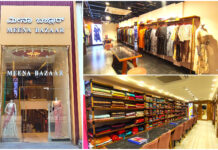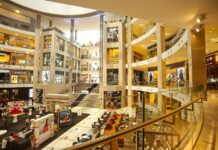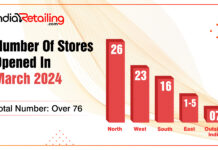Retail industry in India is undoubtingly one of the fastest growing retail industry in the world. It is the largest among all industries accounting to 10 percent of the country GDP and employs around 8 percent of the workforce.
The retail industry is an experiential motley that is currently going through a robust transformation. Be it employing new technologies or exploring new store formats, revamping business strategies or creating personal experiences; retailers are indeed getting ready for the future by looking beyond conventional retail and evolving along with their modern consumers.
India is also expected to become the world’s fastest growing e-commerce market, driven by robust investment in the sector and rapid increase in the number of Internet users.
As the opportunities are immense, let’s take a look what retail trends the stalwarts think will rule in 2019:-
1. Harkirat Singh, Managing Director, Woodland
The Indian apparel and footwear industry contributes the second largest share in the retail industry and has witnessed major shifts in dynamics in last few years where the consumer has become the King of the Market.
Let’s take a look at 5 retail trends to look forward to in 2019.
– Customization – The need for customized products and services is increasing thereby pushing the demand for personalized goods and services. With a pragmatic approach, the interface between companies, brands and customers will improve. Social media conversation tracing is going to be trending in 2019, which is a ground-breaking path to the future of handling customer behavior for tailor-made solutions. Also, studies reveal customers come down in favor of personalization — up to a point. They enjoy seeing products and deals personally relevant to them.
– Brand Experience – It’s not just about selling the products to the customers but also providing them with the best experience too. Most retailers recognize this shift, but the majority struggle with strategies to transform their organization to deliver on consumers’ increasingly demanding expectations. Emerging online brands naturally seek to disrupt traditional ways of doing business and developed digital-first models that have created better experiences.
On the other hand, established retail brands are burdened with legacy systems that are not optimized for today’s environment. The core – people, service, and experience – are strength to maintain and to satisfy today’s consumer they must integrate the flow of information and resources across the networks of employees, stores and partners.
Hence, experiences will make a compelling occurance that consumers will always remember and be more than happy to share with one another.
– Customer Retention – Customer retention is often far more effective and profitable than customer acquisition. An individual shopper want personal recognition. While loyalty programs offer rewards to existing customers the challenge is the acquisition of new customers. Innovation in content is the key to retaining and acquiring customers.
– Retailers that step up their social media strategies will thrive – The rise of Instagram Stories, Facebook Live and messenger apps will fundamentally change how retailers interact with consumers online. Simply posting photos or updates on a brand’s social media handles won’t work anymore. Retailers will need to up their social media game and use social networks and apps to tell stories and engage with fans in real time.
– Display – Retail displays is a strategic aspect of the business that can help attract customers, retain their interest, and increase sales. Visual merchandising helps to set a brand apart from competition by creating attractive and fascinating windows that can pull the consumer in to the store. Effective retail displays attract potential customers to the store. When designing displays, choose engaging colours, unique décor and stock arrangements to appeal both the head and the heart of customers.
Once the brand has attracted potential customers, the brand can Improve chances of making a sale by doing research to see what works in other retail spaces, and keeping an eye on how customer traffic flows through the store.
2. Sharad Venkta – MD & CEO, Toonz Retail
We have seen the retail industry change dramatically in the past couple of decades, and one of the main reasons for the same is the growing internet connectivity, which has led to the rise in the number of smartphones. The preferences of the consumers have changed; they have become more and aware about the latest development that has taken in the market. Not only this, the consumers are also willing to accept the change that the market will bring along.
Some of the industry trends that we can see in the year 2019 are as follows:
– Rise of millennials: Coming Years will see a sharp rise in millennials. These will be the first lot who are exposed to higher technology, are heavily social in nature and soon will have purchasing power as well. Retail will see a dynamic shift in terms of process, technology & strategy.
– Data mining using AI tech: Data analytics will be used to gain and retain customers using AI and this will be the differentiating factor. Merchandise, Processes, offers & communication are expected to become smarter with the help of customer trends and behavior. The offers by the brand and the communication with the customer will have to be more personalized and communicated at the right time. With the help of this technology, brands will be able to garner more and more data so that the customers are able to interact with the brand and then take recommendations from them on the same.
– MutliChannel: Market is becoming more dynamic and there cannot be a single mode to reach to customers. Moving from omnichannel to multichannel, where the products are available in more places and deeper markets. Instead of single touch points, focus will be to widen the opportunitiesto reach and convert the potential customer. 2019 start seeing collaborations of similar target audience products coming together for better reach. It will be seen that in order to retain their customers, the brands will have to be actively present on all the places and streamline the entire process. The brands will have to integrate across all the channels, which also includes their website and social media along with the traditional brick and mortar.
– Deeper Markets: Recently, it has been seen that smaller towns have shown tremendous growth. With the rise in internet penetration, increase in disposable income, retail will see more growth in tier 2 -3 cities in the coming year. Over time, brands have also started to know their customers in a much better way and this has helped the brands in making the right decision and providing the right product to their customers.
– Experiential Marketing: Traditional model that focused only selling is slowly declining with each passing year. Consumers prefer a more engaging experience – whether it is online or offline. They like to engage with brands and products before buying. Now, we can see that consumers are slowly and steadily moving away from the old format and are looking for a more engaging experience. The brand should, however, understand that just remodeling will not work. On the other hand, the brand will have to create a more and more enriching experience for the user. In order to make it engaging in nature, brands are mixing the traditional elements with that of mobile application and other activities.
3. Rajinder Mattoo, Head Sales, Vajor
– Product Representation within the store/ Online: Customers will prefer products where retailers are able to show an enhanced value in terms of VM elements, the environment built around it, stories that the customer can link to his aspiration about fashion. While props become a useful tool in offline environment, photo shoots and crisp product feature description helps the online conversion substantially.
– Omnichannel Experience: With paucity of time and busy schedules, this form of shopping is becoming a preference whereby customers browse through the selection within the comfort of their homes, make a buying decision and just want to go and collect from the nearest store of their location. Gives them an opportunity to experience the look & feel of the product and take corrective action if needed. Even returning through this channel is far more convenient to the customer.
– Window display: Is the driver of the footfall especially within Mall environments also impacting conversion. Windows which are aesthetically designed with a right balance of theme, color, brand representation and customer aspiration act as magnets for consumers to be driven to stores and eventually conversion.
– Store Experience/ Website experience: A seamless experience on the website with a right mix of category and brand representation and fuss free payment gateway experience would be the key drivers of online business. Customers of today do not want to spend too much time on a site/page and hence download speed and crisp home page communication which describes the brand in very little words is the need of the hour and shall only help quicken up the buying decisions.
– Social Media Initiatives: Need to move from posting the content and inviting likes/dislikes to a more interactive mode. This applies to mediums like Instagram and Facebook which are frequented by majority of social media users.
4. Ankita Bajaj Shankar, Marketing Lead, Vans India
Retail industry is still taking off in the country with the organised retail slowly inching up its share of the pie. Expanding cities and change in consumer behavior is only helping organised retail get greater share of the consumer wallet. Few trends to watch out for in 2019 are:
– Cross-channel strategies or Omnichannel as we know it, will open up a world of opportunities for the brands and consumers alike. The buyer will have more options to choose from and his interaction with the brands extend to all touchpoints the brand has to offer. For brands it helps offering a holistic consumer experience.
– Enhancing consumer’s retail store experience through technology will help to understand the consumer better. This will lead to assisted selling, personalized offers etc. AI will change the game here.
– Concept stores will help consolidate all the brands in a particular category together with an enhanced store look and feel. For ex: Specialized Sneaker doors selling exclusive drops across brands
– Offline and Online Brand Communication integration will be another powerful tool to make sure the consumer is seeing the same brand story or language across platforms. From his social media feed to the drop down in the mall, he is seeing one story from the brand.
– Stores will focus on selling the experience more than the product as it helps them connect at a more deeper level with the consumers and hence turn them into brand advocates.
5. Devangi Parekh, Creative Director, Aza Fashions
Retail worldwide has witnessed a huge paradigm shift, and technology has been the strongest force in driving this change. The future of retail will be determined by smart retailers who seamlessly integrate technology across departments to improve operations and customer experiences. This includes everything from trend forecasting and creating unique, personalized experiences based on each customer’s behaviour to offering virtual trials and actively engaging across channels. Here are five predictions for retail in 2019:
– A robust Omnichannel experience will be more important than ever. Albeit a hyped buzzword, omnichannel strategy remains at a nascent stage for many retailers. As an increasing number of pure online players enter the brick-and-mortar space either with experiential stores or through acquisitions, they will untap the benefits of an integrated supply chain and improved buying experiences that include the option to buy online and pick up from/ return to the store; try sizes in the store and order online, in-store alterations, etc. Players with seamless experiences across channels will be able to derive competitive advantages over other players.
– Augmented Reality will enhance shopping experiences. So far employed in mostly gimmicky ways by retailers, AR will become the norm. Whether used to virtually try beauty products and clothing online, at a kiosk in a mall or in a store’s mirror or to play a game to unlock special discounts and rewards on a mobile device, AR engages consumers in new and interesting ways.
– Employing artificial intelligence and machine learning will be imperative to driving sales. Whether to book a rental car, find the best deal, or automatically re-order supplies, customers will rely on AI to manage their lives. Retailers are already using machine learning for better targeting and improved recommendations; the applications are myriad.
– Capturing market share in fashion will be important for e-commerce players. With sizeable margins compared to other categories, fashion will continue growing as more customers buy online. From NRIs in California to customers in Tier II cities, our customers at azafashions.com purchase high value items for special occasions online. As logistics networks and thus accessibility across zip codes improve, reducing delivery timelines, customers will prefer the convenience of buying fashion online.
– Social media continues to heavily influence millennial buying decisions, impacting retailer production cycles. Runway trends from Milan and New York are transmitted instantaneously through channels like Instagram, Snapchat, Youtube etc. Instant dissemination of information has led to the death of seasons in favour of the see-now buy-now model. Retailers that are unable to deliver instant gratification will not survive, as customers are no longer ready to wait 3-6 months to get access to fashion trends, and copycats rush to deliver the same thing in a shorter timeline. Brands that leverage social media channels to have an open conversation with followers will be able to occupy more mind and eventually wallet share. It is perfectly normal to begin a conversation on Snapchat, continue it on Instagram, and culminate it in a purchase through WhatsApp.








